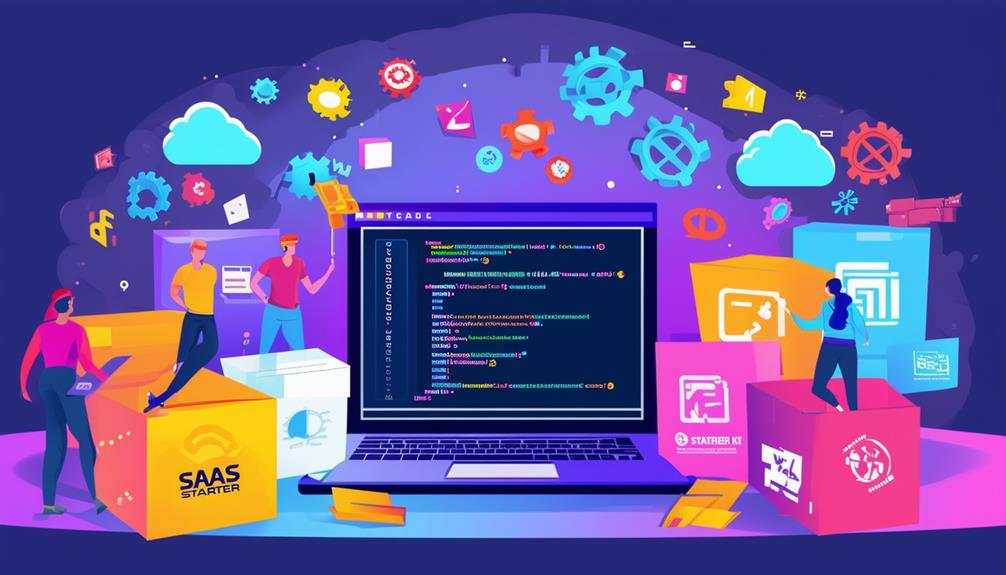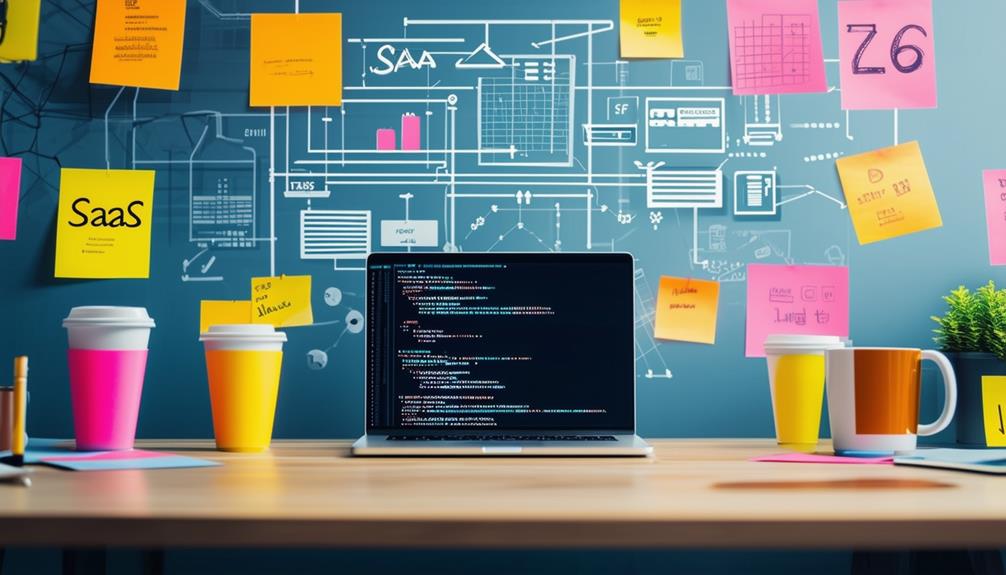When you’re starting on a SaaS project, selecting the right boilerplate can make or break your development process. It’s not just about finding a template; it’s about laying a foundation that aligns with your project’s goals, scalability needs, and technical requirements. You’ll need to evaluate factors like technology stack compatibility, security features, and customization options. But how do you navigate through the myriad of choices available? The key lies in a systematic approach that takes into account your specific needs and future aspirations. Let’s explore the critical factors that will guide you towards making an informed decision for your SaaS venture.
Understanding SaaS Boilerplates
SaaS boilerplates are pre-built templates that can considerably accelerate your software development process, providing a foundation for creating scalable and maintainable cloud-based applications. These templates typically include essential components such as user authentication, database integration, API structures, and basic UI elements. By leveraging a SaaS boilerplate, you can save significant time and resources, allowing you to focus on developing your unique features and business logic.
When considering a SaaS boilerplate, it’s vital to understand its core elements. Most boilerplates offer a tech stack that includes popular frameworks like React, Angular, or Vue.js for the frontend, and Node.js, Django, or Ruby on Rails for the backend. They often come with pre-configured databases, containerization solutions, and CI/CD pipelines. Additionally, many boilerplates incorporate best practices for security, performance optimization, and code organization.
It’s important to note that while boilerplates can jumpstart your development, they’re not one-size-fits-all solutions. You’ll need to evaluate each option based on your project requirements, team expertise, and scalability needs. By understanding the components and capabilities of different SaaS boilerplates, you can make an informed decision that aligns with your project goals and long-term vision.
Assessing Your Project Requirements
Before diving into the selection of a SaaS boilerplate, it’s crucial to thoroughly evaluate your project’s specific requirements and objectives. Start by clearly defining your target audience and the core functionalities your SaaS application needs to provide. Consider factors such as scalability, security requirements, and integration capabilities with third-party services.
Evaluate your team’s technical expertise and preferred technology stack. This will help you narrow down boilerplate options that align with your development capabilities. Determine the level of customization you’ll need, as some boilerplates offer more flexibility than others.
Examine your project’s timeline and budget constraints. Some boilerplates may require more initial setup time but save resources in the long run, while others offer quicker deployment but limited customization. Consider your long-term maintenance needs and how well the boilerplate supports ongoing updates and feature additions.
Analyze your data management requirements, including storage, processing, and compliance with relevant regulations like GDPR or HIPAA.
Evaluating Technology Stack Compatibility
Compatibility between your chosen SaaS boilerplate and your existing technology stack is vital for seamless integration and efficient development. To evaluate this compatibility, you’ll need to take into account several key factors.
First, examine the programming languages and frameworks used in the boilerplate. Verify they align with your team’s expertise and your project’s requirements. For instance, if you’re proficient in JavaScript, a Node.js-based boilerplate might be ideal.
Next, assess the database compatibility. Does the boilerplate support your preferred database system, such as MySQL, PostgreSQL, or MongoDB? Mismatched database technologies can lead to significant integration challenges.
Evaluate the front-end technologies as well. If you’re committed to React, a boilerplate with Angular components won’t be suitable. Look for boilerplates that use your preferred UI libraries and frameworks.
API compatibility is another vital factor. Confirm the boilerplate supports the APIs you plan to integrate, such as payment gateways or third-party services.
Lastly, evaluate the deployment environment compatibility. If you’re using a specific cloud provider or containerization technology, choose a boilerplate that supports these platforms.
Scalability and Performance Considerations
While evaluating compatibility is important, you’ll also need to contemplate how well your chosen SaaS boilerplate can handle growth and maintain performance as your user base expands.
Scalability is vital for long-term success, and your boilerplate should support both vertical and horizontal scaling. Look for boilerplates that incorporate microservices architecture, allowing you to scale individual components independently. This approach can greatly improve resource allocation and overall system performance.
Additionally, consider boilerplates that support containerization technologies like Docker, which facilitate easy deployment and scaling across multiple servers.
Examine the boilerplate’s database management capabilities. It should support database sharding and replication to handle increased data loads efficiently. Caching mechanisms, such as Redis or Memcached, are also essential for optimizing performance under heavy traffic.
Assess the boilerplate’s ability to handle asynchronous processing and background jobs. This feature is vital for maintaining responsiveness during peak usage periods. Look for integration with task queues like RabbitMQ or Apache Kafka.
Security Features and Compliance
Security features and compliance standards are paramount when selecting a SaaS boilerplate, as they’ll directly impact your ability to protect user data and meet regulatory requirements.
When evaluating boilerplates, prioritize those with built-in security measures such as encryption, authentication, and authorization mechanisms. Look for features like SSL/TLS support, secure password hashing, and two-factor authentication options.
Consider boilerplates that offer compliance-ready frameworks, especially if your SaaS will handle sensitive data or operate in regulated industries. Seek options that align with standards like GDPR, HIPAA, or PCI DSS. Check for features that facilitate data protection, such as user consent management and data anonymization tools.
Assess the boilerplate’s approach to secure coding practices. Look for implementations that follow OWASP guidelines and offer protection against common vulnerabilities like SQL injection and cross-site scripting (XSS). Evaluate the frequency of security updates and the community’s responsiveness to reported issues.
Don’t overlook the importance of logging and monitoring capabilities. Choose boilerplates that provide robust audit trails and integrate easily with security information and event management (SIEM) systems. This will enhance your ability to detect and respond to potential security incidents promptly.
Customization and Flexibility Options
Beyond robust security measures, your SaaS boilerplate’s customization and flexibility options will greatly impact your ability to tailor the solution to your specific business needs and scale effectively. When evaluating boilerplates, consider these key factors:
- Modularity: Look for a boilerplate with a modular architecture that allows you to add, remove, or modify components without affecting the entire system. This enables easier customization and maintenance.
- API Integration: Verify the boilerplate supports seamless integration with third-party APIs, allowing you to extend functionality and connect with other tools in your tech stack.
- Theming and UI Customization: Check if the boilerplate offers robust theming options and UI customization capabilities to align with your brand identity and user experience requirements.
- Scalability: Assess the boilerplate’s ability to handle increased loads and user growth. Look for features like horizontal scaling and load balancing support.
- Extensibility: Evaluate the ease of adding new features or modifying existing ones. A well-documented codebase and clear extension points are vital.
Community Support and Documentation
A thriving community and thorough documentation are essential lifelines for developers adopting a SaaS boilerplate. When evaluating options, you’ll want to assess the strength of these support systems. Look for boilerplates with active GitHub repositories, high star counts, and frequent commits, as these indicate ongoing development and user engagement.
Check the project’s documentation quality. Extensive guides, API references, and code examples are vital for smooth implementation. Evaluate the clarity and depth of the documentation, ensuring it covers setup, customization, and troubleshooting.
Examine community forums, Stack Overflow tags, and Discord channels related to the boilerplate. Active discussions and prompt responses to questions signify a supportive ecosystem. Consider the number of contributors and the frequency of pull requests as indicators of community involvement.
Look for tutorials, blog posts, and video content created by the community. These resources can provide valuable insights and real-world implementation examples. Additionally, assess the responsiveness of maintainers to issues and feature requests.
Pricing and Licensing Models
When selecting a SaaS boilerplate, you’ll need to carefully consider its pricing structure and licensing terms, as these factors can greatly impact your project’s long-term costs and legal compliance.
Many boilerplates offer tiered pricing models, ranging from free open-source options to premium enterprise packages. It’s essential to evaluate these tiers against your current needs and future scalability requirements.
Open-source boilerplates often come with permissive licenses like MIT or Apache 2.0, allowing you to use, modify, and distribute the code freely. However, some may have copyleft licenses like GPL, which require you to release your modifications under the same license.
Commercial boilerplates typically offer perpetual or subscription-based licensing models, with varying levels of support and updates.
When comparing pricing, consider factors such as the number of users, deployment options, and included features. Some boilerplates charge based on the number of active users or API calls, while others offer unlimited usage within specific tiers.
Be certain to calculate the total cost of ownership, including potential customization and maintenance expenses. Always review the licensing terms carefully to guarantee compliance with your business model and avoid any legal complications down the line.
Testing and Deployment Capabilities
While pricing and licensing set the foundation, robust testing and deployment capabilities can make or break your SaaS boilerplate’s effectiveness in real-world scenarios.
You’ll want to prioritize boilerplates that offer extensive testing frameworks and streamlined deployment processes.
Look for boilerplates that support automated testing, including unit, integration, and end-to-end tests. These features guarantee your application remains stable as you scale. Additionally, seek out options with built-in continuous integration and continuous deployment (CI/CD) pipelines. This automation greatly reduces the risk of human error and accelerates your development cycle.
Consider boilerplates that offer containerization support, such as Docker integration. This feature enhances portability and simplifies deployment across different environments. Also, check for cloud platform compatibility. Boilerplates that seamlessly integrate with major cloud providers like AWS, Azure, or Google Cloud can save you considerable time and effort.
Lastly, evaluate the boilerplate’s monitoring and logging capabilities. Robust error tracking, performance monitoring, and log management tools are essential for maintaining a healthy SaaS application.
To Wrap Up
You’ve now got the tools to choose the best SaaS boilerplate for your project.
Remember to prioritize your specific needs, tech stack compatibility, and scalability.
Don’t forget to assess security features, customization options, and community support.
By carefully evaluating these factors, you’ll set your project up for success.
Always consider long-term growth and stay informed about industry trends to make the most of your chosen boilerplate.






